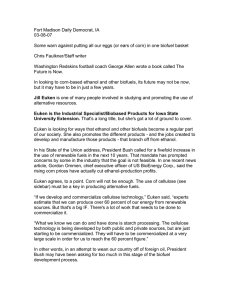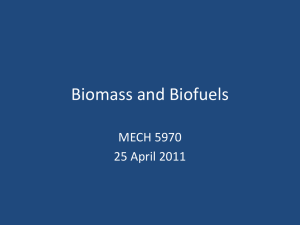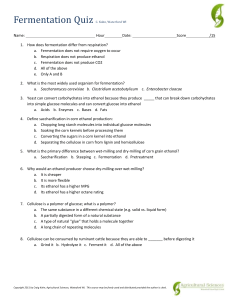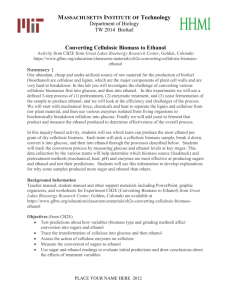Slide Notes - MIT Biology
advertisement
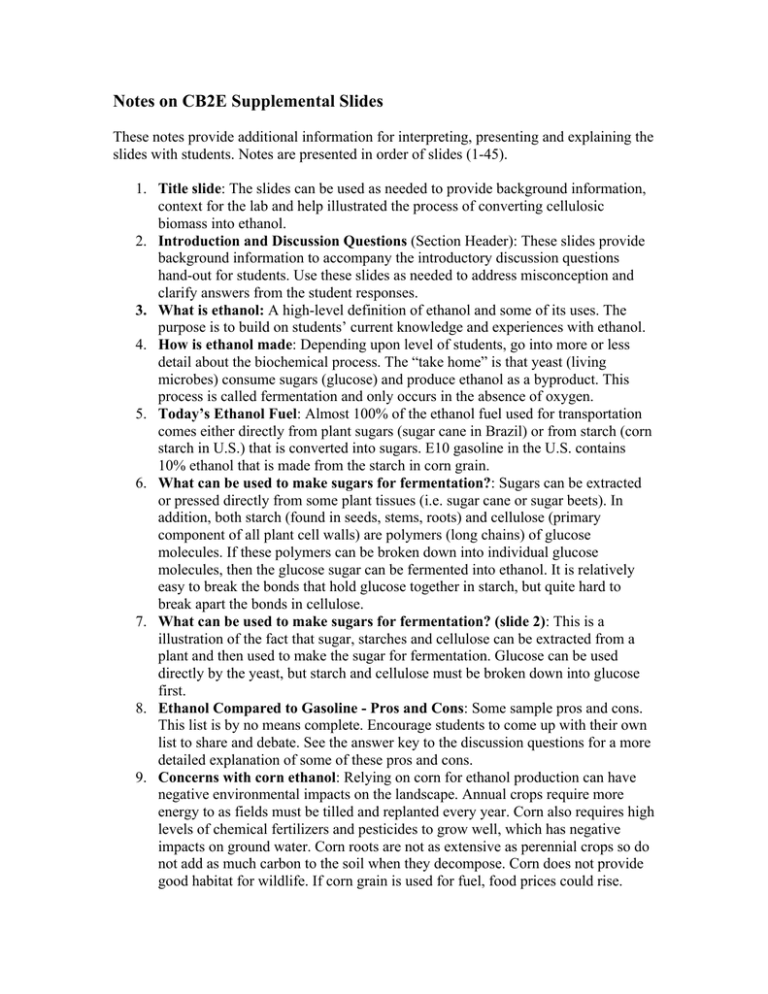
Notes on CB2E Supplemental Slides These notes provide additional information for interpreting, presenting and explaining the slides with students. Notes are presented in order of slides (1-45). 1. Title slide: The slides can be used as needed to provide background information, context for the lab and help illustrated the process of converting cellulosic biomass into ethanol. 2. Introduction and Discussion Questions (Section Header): These slides provide background information to accompany the introductory discussion questions hand-out for students. Use these slides as needed to address misconception and clarify answers from the student responses. 3. What is ethanol: A high-level definition of ethanol and some of its uses. The purpose is to build on students’ current knowledge and experiences with ethanol. 4. How is ethanol made: Depending upon level of students, go into more or less detail about the biochemical process. The “take home” is that yeast (living microbes) consume sugars (glucose) and produce ethanol as a byproduct. This process is called fermentation and only occurs in the absence of oxygen. 5. Today’s Ethanol Fuel: Almost 100% of the ethanol fuel used for transportation comes either directly from plant sugars (sugar cane in Brazil) or from starch (corn starch in U.S.) that is converted into sugars. E10 gasoline in the U.S. contains 10% ethanol that is made from the starch in corn grain. 6. What can be used to make sugars for fermentation?: Sugars can be extracted or pressed directly from some plant tissues (i.e. sugar cane or sugar beets). In addition, both starch (found in seeds, stems, roots) and cellulose (primary component of all plant cell walls) are polymers (long chains) of glucose molecules. If these polymers can be broken down into individual glucose molecules, then the glucose sugar can be fermented into ethanol. It is relatively easy to break the bonds that hold glucose together in starch, but quite hard to break apart the bonds in cellulose. 7. What can be used to make sugars for fermentation? (slide 2): This is a illustration of the fact that sugar, starches and cellulose can be extracted from a plant and then used to make the sugar for fermentation. Glucose can be used directly by the yeast, but starch and cellulose must be broken down into glucose first. 8. Ethanol Compared to Gasoline - Pros and Cons: Some sample pros and cons. This list is by no means complete. Encourage students to come up with their own list to share and debate. See the answer key to the discussion questions for a more detailed explanation of some of these pros and cons. 9. Concerns with corn ethanol: Relying on corn for ethanol production can have negative environmental impacts on the landscape. Annual crops require more energy to as fields must be tilled and replanted every year. Corn also requires high levels of chemical fertilizers and pesticides to grow well, which has negative impacts on ground water. Corn roots are not as extensive as perennial crops so do not add as much carbon to the soil when they decompose. Corn does not provide good habitat for wildlife. If corn grain is used for fuel, food prices could rise. 10. What is cellulosic biomass? (Section header): The slides in this section define the term, provide examples, and briefly delve into the structure and key chemical components. 11. What is cellulosic biomass: Cellulosic biomass examples include rough, fibrous plant parts that are made up mostly of cellulose (cell walls). Corn stalks and leaves, called corn stover, is pictured along with a field of switchgrass. 12. Sources of cellulose: Some additional examples of cellulose sources. Encourage students to brainstorm other examples. 13. What is cellulose?: This diagram helps students understand how cellulose fibers make up plant cell walls. Within the cell wall cellulose fibers are intertwined with hemicellulose and lignin molecules which help bind the fibers together and resist degradation. At the molecular level, students can see the crystalline structure of cellulose fibers that are actually long chains of glucose molecules. The goal of this lab is to release the cellulose through pretreatment and then chop it up into glucose using special enzymes called cellulases. 14. Plant Cell Wall Structure: The plant cell wall is made up of three primary components. The most useful component for producing ethanol is the cellulose, which is made up of long chains of glucose molecules. The cellulose is bound up with hemicellulose and lignin. Hemicellulose, like cellulose, is also a carbohydrate but is harder to breakdown and made up of 5-carbon sugars, which are not readily consumed by most yeast (glucose is a 6-carbon sugar). Lignin is a complex organic molecule that helps bind biomass together, resists decay and gives biomass a dark color. Dark wood has a lot of lignin. Lignin can be burned for energy and is increasingly being studied as a potential source of chemicals that are currently made from petroleum. For the purpose of this lab, lignin and hemicellulose are basically obstacles for accessing the cellulose, which can be converted into sugar and then ethanol. 15. Cellulosic Biofuels: Cellulose, by some estimates, is the most abundant molecule on earth. That is because it is the primary component of plant cell walls and plant cell walls are everywhere, both in living and decomposing plants of all types. Cellulose therefore represents a huge potential pool of stored chemical energy if we could convert it into fuel. Unfortunately this is not easy to do as students will see in this lab. Some plants and some plant parts have more cellulose than others and there is a great deal of variability in how easy it is to access and then break down the cellulose in a plant’s cell wall to produce glucose. 16. Biomass Feedstocks Available for 1 Billion Ton Harvest Annually: A 2005 Department of Energy study estimated that the US could sustainably harvest 1 billion tons of cellulosic biomass every year. The DOE estimated that if this biomass were converted into fuel, it would supply 30% of our demand for transportation fuel. This graph illustrates what sources would contribute to the billion ton annual harvest. 17. Biomass Resources Available in the United States: An intriguing informative map to promote discussion. What regions of the US have the most and least biomass resources available? Why? What type biomass resources (i.e. grasses, wood, crop residues) are available in different regions? Your region? 18. Background Information and Graphs (Section header): These graphs can be used to provide some context for how ethanol biofuel could contribute to meeting our overall energy needs while helping to reduce greenhouse gas emissions. 19. US Energy Consumption: Transportation accounts for almost 1/3 of the country’s total energy consumption. In 2012, 90% of our transportation energy came from nonrenewable petroleum. It is unlikely in the near future (before 2040) that we will see a decline in the reliance on the internal combustion engine, especially for long-distance, trucking, shipping and aviation. 20. US Energy Consumption, Biofuels Potential: According to DOE estimates, ethanol from cellulosic biomass and other biofuels could replace 30% of our liquid transportation fuel. The challenge is to figure out an efficient method to convert cellulosic biomass into ethanol as students will explore in this lab. 21. Regular Conventional Oil Production and Discovery: Oil is a nonrenewable resource and there is a need to look to other sources for liquid fuels in the near future. This graph demonstrates the lag between peak oil discovery and production. Although discovery of new oil reserves peaked in the mid-sixties, production (extraction and refining) has continued to increase to meet global demand. Production is expected to decline in the near future as existing reserves diminish and it becomes more expensive to extract and refine existing oil. This could drive up fuel costs and create energy shortages if alternative fuels are not developed. 22. U.S. Energy Sources: Historical: Over the last 200 years, change has been the norm in terms of what energy is used to power the U.S. economy. Given this pattern there is reason to be optimistic that we can transition to renewable energy sources such as biofuels over the next 50 years. Ask students to explain what energy was used for transportation over the last 100 years and how new technology allowed society to adapt to new energy sources, i.e. animal powered wagons to coal powered steam engines to oil powered cards. Every chemical energy source originated from the sun. 23. Energy Densities by Volume: When comparing different sources of energy for transportation, it is important to consider energy density. High density fuels are much easier to transport, which is especially important for vehicles. This helps to illustrate how valuable (energy dense) petroleum is compared to other fuels. A gallon of ethanol contains 2/3 the energy as a gallon of gasoline. But this is much better than wood. How much wood would one have to burn to produce the energy contained in a gallon of gasoline? Almost 70x the volume according to the graph. Compared to raw biomass, ethanol has a much higher energy density and is much more valuable as a transportation fuel. 24. Renewable Fuel Standard (EPA-2013): In 2005 the Renewable Fuel Standard was created under the Energy Policy Act (EPAct). This standard mandates increasing the domestic production and use of renewable biofuels, including corn ethanol, sugar cane ethanol, biodiesel and cellulosic ethanol. Goals include increase energy independence and reducing greenhouse gas emissions. To achieve the goals for cellulosic ethanol production will require technological breakthroughs to make the process more efficient and cost-effective. 25. What is the Great Lakes Bioenergy Research Center (GLBRC): The GLBRC is one of three Bioenergy Research Centers (BRC) with the mission of pursuing scientific discoveries and technological breakthrough to sustainably produce advanced biofuels from cellulosic biomass. GLBRC receives 25 million dollars a year to conduct this research. Research areas span the entire biofuel production “pipeline” from trials testing different crops in fields to biochemical research on the most efficient methods to convert crops to fuel. Hundreds of scientists and engineers are working together to find solutions to a common problem. 26. GLBRC 1 of 3 DOE Bioenergy Research Centers: Bioenergy research is a major collaborative effort between the 3 DOE-funded Centers, which receive 75 million a year combined. GLBRC is the only BRC based at a University (UWMadison and Michigan State University). The map illustrates the magnitude of this research undertaking (analogous to the Manhattan Project but for biofuels). 27. GLBRC Research Roadmap: Scientists and engineers are working together on different aspects of the biofuel production “pipeline”. Plant biologists and breeders are studying how to design plants that produce the most accessible energy. Chemists and biochemists are studying methods to break those plants down into sugars. Microbiologists are studying efficient methods for microbes, such as yeast, to convert those sugars into fuels, such as ethanol. Ecologists and economists are investigating different crop and fuel production scenarios to determine whether the system is sustainable. Key considerations with sustainability include how much greenhouse gases (CO2) are released in the production process, how much energy is required to grow and convert plants to fuel, and whether a production system is economically viable. 28. GLBRC Who We Are: This is a brief summary of the scientists, staff and students working together at GLBRC to find solutions to this pressing energy challenges. 29. Process for Making Cellulosic Ethanol (Section header): This section provides an overview of the cellulosic biofuel production pipeline or the key steps required to make ethanol from biomass. This process is under development. Large-scale commercial cellulosic ethanol plants are just beginning to come online. 30. Moving Beyond Corn Ethanol: The goal is to use cellulose rather than starches and sugars to make ethanol. Cellulose is much more abundant and cellulosic biomass is much easier to grow. The flow chart on the right outlines the steps for converting cellulosic biomass, such as wood or grass, into ethanol. First the biomass must be “pretreated” through grinding, heat, and/or chemicals to break down the plant cell walls and release the cellulose. Next, enzymes called cellulases digest the cellulose fibers into individual glucose molecules. Finally the glucose sugar is fed to yeast in the absence of oxygen which produces ethanol through the process of fermentation. 31. How Cellulosic Ethanol is Made: This illustration how the process of cellulosic ethanol production might happen at a commercial refinery. Biomass is moved through the pretreatment, enzyme digestion and fermentation steps described in the previous slide. Distillation is the final step that would be required to extract pure ethanol from the fermentation step. Engineers are trying to determine ways reduce the energy and material inputs in this process to make it more efficient and cost effective at each step. Potential engineering problems: 1.) What is the most efficient pretreatment method?, 2.) How can we develop more effective enzymes, use less enzymes or reuse enzymes in this process? 3.) Can we design yeast to produce more ethanol? 4.) Is there a way to combined enzyme digestion and fermentation in one step (the fewer the steps, the more efficient the process)? Students can propose their own solutions in this lab. 32. Biofuels Life Cycle: This illustration helps students visualize the process by which cellulosic ethanol might be produced from “plow to pump”. Corn ethanol is currently produced and distributed through this general process. The goal is to replace the corn grain feedstock with cellulosic biomass such as corn stover, switch grass, agricultural waste, wood, etc. In this lab students will be investigating the process of converting the biomass into ethanol at the “refinery stage”. To assess the overall sustainability of biofuel production system, one must consider the energy inputs, costs and emissions associated with each production and distribution step. In the GLBRC Life Cycle Assessment (LCA) of Biofuels activities students can explore the energy and matter inputs and outputs in this process in more detail. 33. Step 1 - Pretreatment (Section header slide): The goal of pretreatment is to break down the plant cell wall using heat and/or chemicals in order to release the cellulose fibers. Without this step, cellulase enzymes cannot effectively bind to and break down the cellulose into glucose. The slides in this section help students visualize the chemical effects of pretreatment on the plant cell wall. Have students create models of the effects of pretreatment on their biomass samples. 34. Pretreatment: This cartoon illustration show a cross section of a cell wall with the intertwined cellulose, hemicellulose and lignin. The goal is to separate the cellulose from the lignin and hemicellulose. If pretreatment is effective, the cell wall structure breaks down releasing a mixture of cellulose, lignin and hemicellulose. The relative amounts of these three molecules in the cell wall varies between biomass sources. Effective pretreatment methods include combinations of biomass grinding, heat, and various alkaline or acid chemical applications. 35. Effect of Pretreatment on Corn Cob Granule Sclereid Cells: This scanning electron micrograph shows the impacts of a high heat, high pressure, ammonia pretreatment (AFEX) on corn cob cell walls. Note how the cell walls collapse after pretreatment. In the collapsed cell walls, the cellulose is more freely available for the cellulase enzymes to digest. 36. Step 2 – Enzyme Digestion (Hydrolysis): In this stage, special enzymes called cellulases bind to the cellulose fibers and chop them up into individual glucose molecules. The term for this type of chemical reaction is hydrolysis because the enzymes break hydrogen bonds between the glucose molecules in the cellulose. If enzyme digestion is 100% effective, all of the cellulose in the biomass is converted into glucose. GLBRC scientists are working hard to discover and design combinations of enzymes to digest cellulose into glucose. These enzymes are very expensive so the less enzyme that can be used, the more cost effective the process will be. These slides can be used to help students visualize this process. 37. Enzyme Digestion (Hydrolysis): This cartoon helps students visualize the function of cellulase enzymes for “cutting” the cellulose strands into glucose molecules. Yeast cannot consume cellulose in fermentation. Only glucose can be consumed and converted into ethanol by yeast in fermentation. Have students make their own models of how enzymes digestion works. 38. Endocellulase in Action: This is a realistic illustration of a type of cellulase enzyme called endocellulase binding to a cellulose fiber. This complex protein has two domains – one allows the enzyme to bind to the cellulose (binding domain) and the other cuts the cellulose strand (catalytic domain). There are three types of celluases that are required to convert cellulose to glucose. The first, endocellulase, cut the cellulose into short strands. The second, exocellulase, cuts these strands into dimers of two glucose molecules called cellobiose. The third, cellobiase, cuts the cellobiose dimers into glucose molecules. The Celluclast enzyme product recommended for this lab contains a complex mixture of these enzymes which are extracted from a wood-eating fugus called Trichoderma reesii. This slide is only illustrating the action of an endocellulase enzyme. 39. Catalytic Domain Pulling up Cellulose Strand: This model shows the catalytic domain of the endocellulose pulling a cellulose strand up into its active site. The endocellulose has a special 3-D structure that allows it to bind to and pull up the cellulose strand. Cellulase enzymes have evolved in organisms that can eat cellulose. Without these enzymes fungi and other microbes would not be able to decompose wood. Microbes in a cow’s gut produce these enzymes and allow the cow to digest the cellulose in grass. 40. Hydrolysis and Release of the Catalytic Subunit: In the final step the catalytic domain cuts the cellulose strand and is released from the fiber. After release this enzyme would bind to a new section of the cellulose fiber and make another cut. Think how many times this process would occur in one gram of biomass! 41. Step 3: Fermentation: The goal of this final stage is to produce ethanol through fermentation. The glucose is fed to yeast in the absence of oxygen. The yeast have special enzymes that allow them to get some useful energy from the glucose and produce ethanol as a byproduct. Researchers at GLBRC are working to select for and engineer microbes that are more effective at converting the biomass-sugar mixture into ethanol. This includes searching yeast that can tolerate the toxic chemical environment of the digested biomass-sugar mixture. 42. Standard fermentation: A review of the process and chemical formula for fermentation. The picture shows a fermenter used by GLBRC scientists to ferment enzymatically digested biomass into ethanol and carefully measure yeast growth rates, CO2, ethanol and sugar levels over time. With the fermenting samples in their falcon tubes, students will mimic the research process as they measure ethanol and glucose production.


